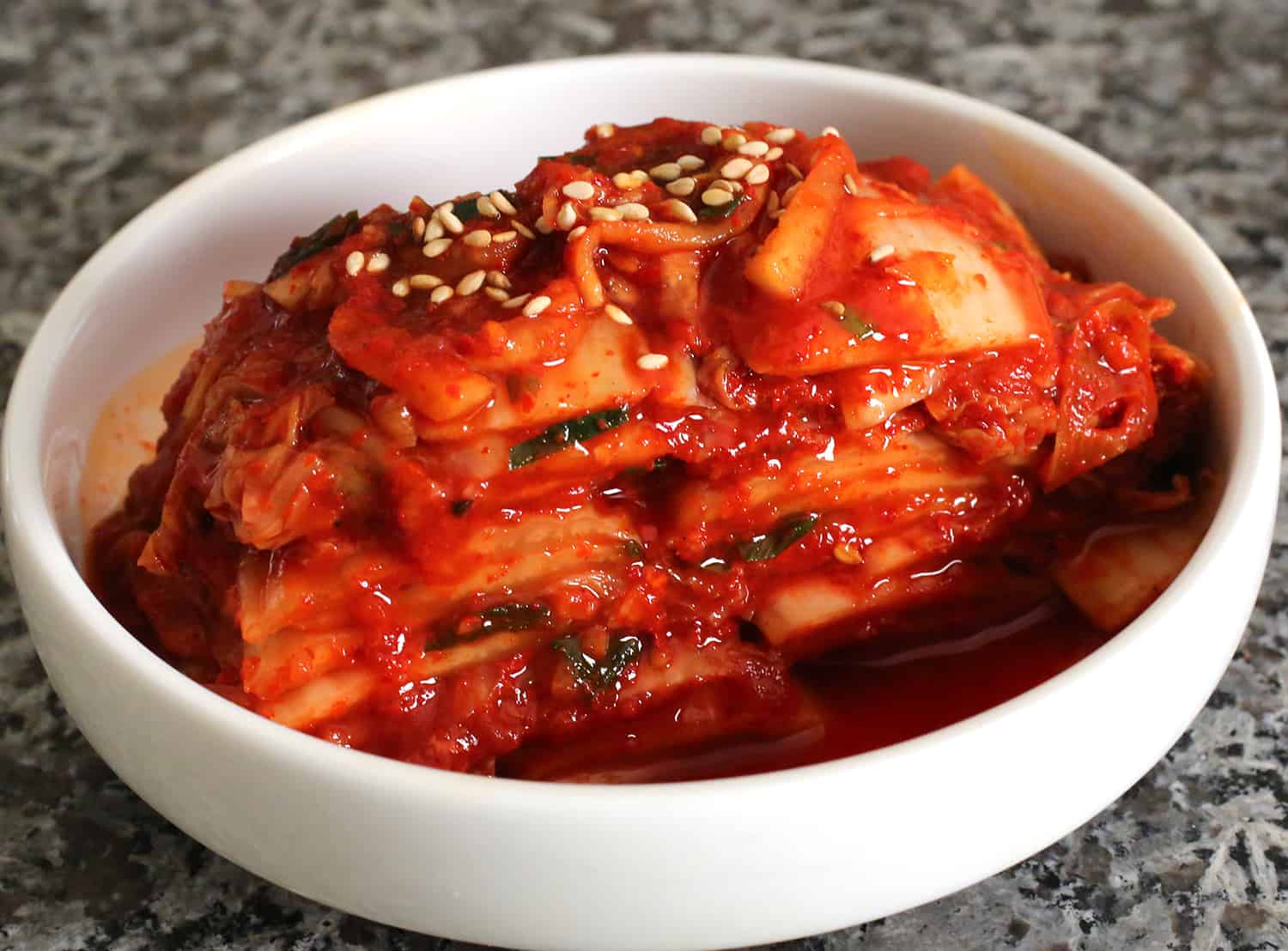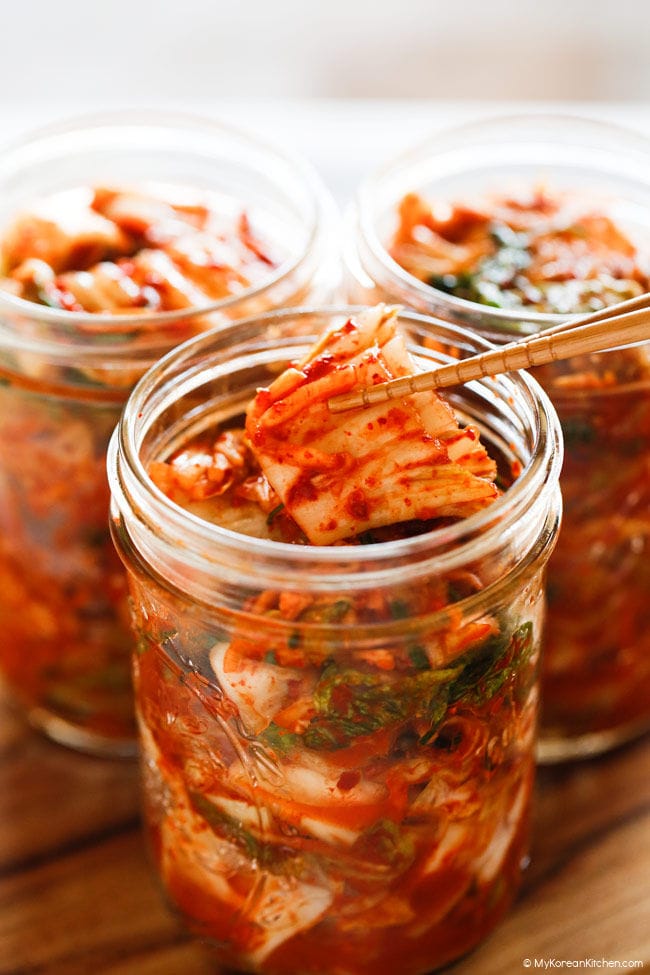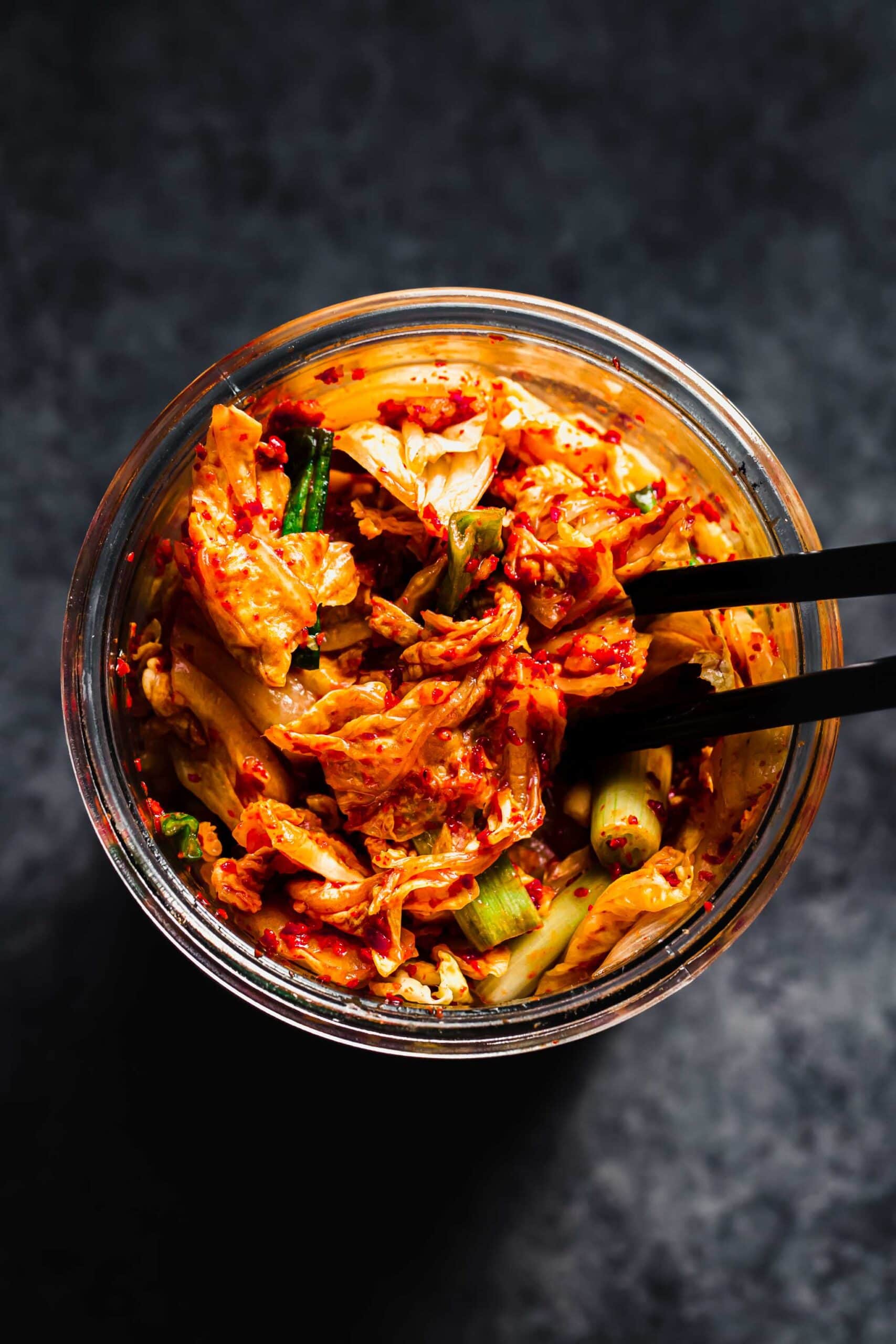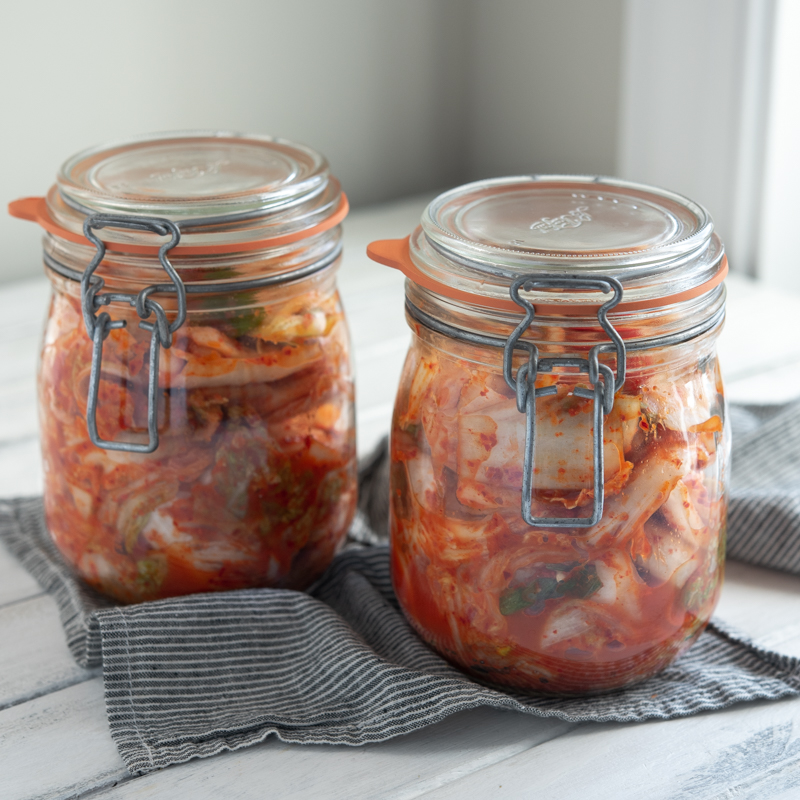
Kimchi Recipe

Learn how to make napa cabbage kimchi, a popular Korean side dish made from fermented napa cabbage, radish, and Korean chives. Includes step-by-step kimchi making instructions, and handy tips for making the best kimchi.
Prep: 150min
Total: 510min
Yield: 7
Serving Size: 1 serving
Nutrition Facts: calories 196 kcal, Carbohydrate 37 g, Protein 9 g, Fat 7 g, Saturated Fat 1 g, Sodium 33425 mg, Fiber 19 g, Sugar 11 g, unSaturated Fat 6 g, servingSize 1 serving
Ingredients:
- 4 kg napa cabbage ((8.8 pounds), remove thick outer cabbage leaves)
- 16 cups water ((3840 ml))
- 1.5 cups Korean coarse sea salt (or natural rock salt (for salt water), (285g / 10 ounces))
- 1/2 cup cooking salt (, medium sized crystals (for sprinkle), (97g / 3.4 ounces))
- 2 Tbsp glutinous rice flour ((sweet rice flour))
- 1.5 cups water ((360 ml))
- 1.5 cups gochugaru ((Korean chili flakes), (141g / 4.97 ounces))
- 540 g Korean radish (or daikon radish (19 ounces), julienned)
- 1 Tbsp fine sea salt
- 3.5 Tbsp Korean fish sauce
- 2 Tbsp salted fermented shrimp (, minced)
- 90 g Korean chives ((3.2 ounces), cut in 5 cm / 2 inch length)
- 140 g carrots ((4.9 ounces), julienned)
- 1/4 cup minced garlic ((42g / 1.48 ounces))
- 1/2 Tbsp minced ginger
- 2 Tbsp raw sugar
- 75 g onion ((2.6 ounces), blended (with a stick blender or vegetable chopper) or finely grated)
Instruction:
- Cut the napa cabbage into quarters and rinse it in running water. Make sure the stem is intact.
- Dissolve the coarse salt in the water (16 cups) in a large bowl. Dip the napa cabbage in the saltwater one at a time and transfer it onto a tray for further salting.Pinch some cooking salt (1/2 cup total for all pickled cabbages) and rub over the thick white part of the cabbage. Open each leaf gently and sprinkle the salt over the thick white part. Repeat this for the rest of the cabbage. Reserve the saltwater from when you soaked the cabbage for later use.
- Put the salted cabbage in a large food grade plastic bag or large bucket (wedge side of the cabbage to be facing up) and pour in the reserved saltwater from step 2. Close the plastic bag. If using a bucket, get something heavy on top of the cabbage to press down (e.g heavy pot with water).Set the cabbage aside for 6 hours to pickle. Rotate the cabbage upside down every 2 hours. Using a large food grade plastic bag will make the turning process much easier than using a large bucket.
- Once the soaking process is finished, rinse the cabbages in running water, especially the thick white part of the cabbage, to get rid of the salt. Place them in a colander and allow to drain for 1 hour.
- While waiting, prepare the glutinous rice paste. Mix glutinous rice flour with the water (1.5 cup) in a saucepan and boil it over medium heat for 5-8 minutes, until it thickens. Once ready, transfer the rice paste to the medium-size bowl and let it cool. Add Korean chili flakes once it has cooled. Then, combine them well.
- Prepare a large mixing bowl and add radish, fine sea salt, Korean fish sauce, and salted shrimp. Leave it for 10 minutes for the radish to salt down. Add Korean chives, carrots, minced garlic, minced ginger, sugar, blended onion, and the Korean chili flakes mixture from step 5. Mix them well. Now the kimchi seasoning / kimchi paste is made, ready for use.
- Place a quarter of a cabbage on a tray. Spread the seasonings over each leaf. (You only need to season one side of the leaf.) 1 to 2 small fistfuls of seasoning is enough per quarter of cabbage. Repeat this step for the rest of the cabbage. Don’t pull the cabbage leaves off the stem, leave them attached so it holds together better.
- Transfer the kimchi into a kimchi container or an airtight container (and put the lid on). Leave it out at room temperature for 24 hours, then move it to the refrigerator. While you can start eating it once it’s chilled, you may want to wait 3-4 more days for it to develop more flavor.
Easy Homemade Kimchee Recipe

This easy Kimchee (Kimchi) recipe will teach you to make authentic kimchee at home. It’s easy to do with these simple steps!
Prep: 25min
Total: 25min
Yield: 16
Serving Size: 1 serving
Nutrition Facts: calories 7 kcal, Carbohydrate 1 g, Cholesterol 7 mg, Sodium 3846 mg, servingSize 1 serving
Ingredients:
- 3 pounds napa cabbage
- 1/2 cup kosher salt
- 12 cups cold water (plus more as needed)
- 4 medium scallions (ends trimmed, cut into 1-inch pieces (use all parts))
- 1/3 cup Korean red pepper powder
- 1/4 cup fish sauce
- 1/4 cup fresh ginger (minced)
- 7 cloves garlic (minced)
- 2 teaspoons dried shrimp (minced)
- 1 1/2 teaspoons granulated sugar
Instruction:
- Cut the cabbage in half lengthwise, then crosswise into 2-inch pieces, discarding the root end. Place in a large bowl, sprinkle with the salt, and toss with your hands until the cabbage is coated. Add enough cold water to just cover (about 12 cups), making sure the cabbage is submerged. Cover with plastic wrap or a baking sheet and let sit at room temperature at least 12 hours and up to 24 hours.
- Place a colander in the sink, drain the cabbage, and rinse with cold water. Gently squeeze out the excess liquid and transfer to a medium bowl; set aside.
- Place the remaining ingredients in a large bowl and stir to combine.
- Add the cabbage and toss with your hands until evenly combined and the cabbage is thoroughly coated with the mixture.
- Pack the mixture tightly into a clean 2-quart or 2-liter glass jar with a tight fitting lid and seal the jar.
- Let sit in a cool, dark place for 24 hours (the mixture may bubble). Open the jar to let the gases escape, then reseal and refrigerate at least 48 hours before eating (kimchi is best after fermenting about 1 week). Refrigerate for up to 1 month.
Easy Kimchi Recipe for Beginners

This kimchi recipe is a beginner’s guide and makes traditional Korean kimchi easily. You can enjoy the healthy benefit of homemade kimchi with this cabbage kimchi recipe.
Prep: 20min
Total: 140min
Yield: 12
Serving Size: 1 serving
Nutrition Facts: calories 79 kcal, Carbohydrate 15 g, Protein 4 g, Fat 2 g, Saturated Fat 0.4 g, Cholesterol 1 mg, Sodium 5896 mg, Fiber 6 g, Sugar 5 g, unSaturated Fat 1.5 g, servingSize 1 serving
Ingredients:
- 3 lb (1.3 kg) napa cabbage (about 1 medium head)
- 2/3 cup (200 g) Korean coarse sea salt
- 1 bunch green onion (sliced)
- 2-3 fresh red chili (optional) (sliced )
- 1/2 large onion (diced)
- 7-8 cloves garlic
- 1 inch ginger (peeled and diced)
- 1/2 large sweet apple (seeded and diced)
- 2/3 cup (60 g) Korean chili flakes (gochugaru)
- 1 tbsp sugar
- 4 tbsp Korean anchovy sauce
- 1 tbsp Korean salted shrimp
- 3 tbsp cooked white rice
- 1/2 cup (120 ml) sea kelp stock (or water (See note))
Instruction:
- Let the cabbage soak for 2 hours, turning them upside down a couple of times during the soaking. When you bend the white stem part of cabbage, if it bends with a gentle pressure, the brine step is completed. Rinse the cabbage 3 times in water. Drain the cabbage in a colander, pressing down gently to remove excess water.
- Pour the puree in a large mixing bowl. Add Korean chili flakes, and mix well. Taste and adjust the seasoning of paste for your liking. Let the paste rest for 5 minutes, so the chili flakes will get re-hydrated.
- Mix well to coat the cabbage with the seasoning paste. (Wear kitchen rubber gloves to protect your hands from getting stained or smelly.) Taste your kimchi! If your kimchi tastes saltier than you would hope for, don’t worry! Freshly made kimchi usually taste much saltier, but the saltiness will subdue as it ferments.
- Put kimchi in an airtight glass food storage jar(s). Let it sit in a room temperature for 1 day (or as long as 2 days, depending on the temperature). When you see a gas foaming and air bobbles appear, transfer your kimchi to the refrigerator and store it for 4-5 days before you serve. It will last in the fridge for up to 2 months.
